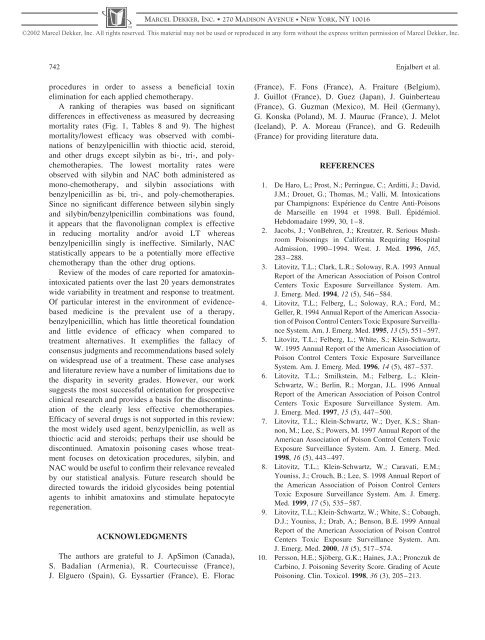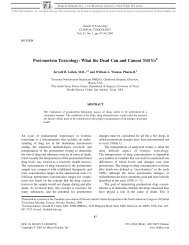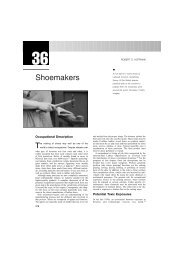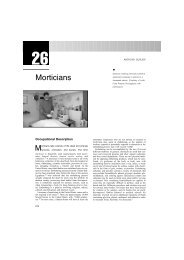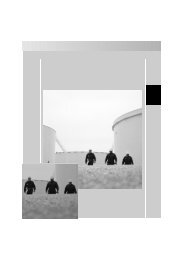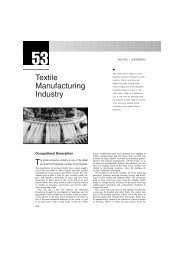9. Treatment of Amatoxin Poisoning-20 year retrospective analysis
9. Treatment of Amatoxin Poisoning-20 year retrospective analysis
9. Treatment of Amatoxin Poisoning-20 year retrospective analysis
Create successful ePaper yourself
Turn your PDF publications into a flip-book with our unique Google optimized e-Paper software.
742<br />
procedures in order to assess a beneficial toxin<br />
elimination for each applied chemotherapy.<br />
A ranking <strong>of</strong> therapies was based on significant<br />
differences in effectiveness as measured by decreasing<br />
mortality rates (Fig. 1, Tables 8 and 9). The highest<br />
mortality/lowest efficacy was observed with combinations<br />
<strong>of</strong> benzylpenicillin with thioctic acid, steroid,<br />
and other drugs except silybin as bi-, tri-, and polychemotherapies.<br />
The lowest mortality rates were<br />
observed with silybin and NAC both administered as<br />
mono-chemotherapy, and silybin associations with<br />
benzylpenicillin as bi, tri-, and poly-chemotherapies.<br />
Since no significant difference between silybin singly<br />
and silybin/benzylpenicillin combinations was found,<br />
it appears that the flavonolignan complex is effective<br />
in reducing mortality and/or avoid LT whereas<br />
benzylpenicillin singly is ineffective. Similarly, NAC<br />
statistically appears to be a potentially more effective<br />
chemotherapy than the other drug options.<br />
Review <strong>of</strong> the modes <strong>of</strong> care reported for amatoxinintoxicated<br />
patients over the last <strong>20</strong> <strong>year</strong>s demonstrates<br />
wide variability in treatment and response to treatment.<br />
Of particular interest in the environment <strong>of</strong> evidencebased<br />
medicine is the prevalent use <strong>of</strong> a therapy,<br />
benzylpenicillin, which has little theoretical foundation<br />
and little evidence <strong>of</strong> efficacy when compared to<br />
treatment alternatives. It exemplifies the fallacy <strong>of</strong><br />
consensus judgments and recommendations based solely<br />
on widespread use <strong>of</strong> a treatment. These case analyses<br />
and literature review have a number <strong>of</strong> limitations due to<br />
the disparity in severity grades. However, our work<br />
suggests the most successful orientation for prospective<br />
clinical research and provides a basis for the discontinuation<br />
<strong>of</strong> the clearly less effective chemotherapies.<br />
Efficacy <strong>of</strong> several drugs is not supported in this review:<br />
the most widely used agent, benzylpenicllin, as well as<br />
thioctic acid and steroids; perhaps their use should be<br />
discontinued. <strong>Amatoxin</strong> poisoning cases whose treatment<br />
focuses on detoxication procedures, silybin, and<br />
NAC would be useful to confirm their relevance revealed<br />
by our statistical <strong>analysis</strong>. Future research should be<br />
directed towards the iridoid glycosides being potential<br />
agents to inhibit amatoxins and stimulate hepatocyte<br />
regeneration.<br />
ACKNOWLEDGMENTS<br />
The authors are grateful to J. ApSimon (Canada),<br />
S. Badalian (Armenia), R. Courtecuisse (France),<br />
J. Elguero (Spain), G. Eyssartier (France), E. Florac<br />
MARCEL DEKKER, INC. 270 MADISON AVENUE NEW YORK, NY 10016<br />
©<strong>20</strong>02 Marcel Dekker, Inc. All rights reserved. This material may not be used or reproduced in any form without the express written permission <strong>of</strong> Marcel Dekker, Inc.<br />
(France), F. Fons (France), A. Fraiture (Belgium),<br />
J. Guillot (France), D. Guez (Japan), J. Guinberteau<br />
(France), G. Guzman (Mexico), M. Heil (Germany),<br />
G. Konska (Poland), M. J. Mauruc (France), J. Melot<br />
(Iceland), P. A. Moreau (France), and G. Redeuilh<br />
(France) for providing literature data.<br />
REFERENCES<br />
Enjalbert et al.<br />
1. De Haro, L.; Prost, N.; Perringue, C.; Arditti, J.; David,<br />
J.M.; Drouet, G.; Thomas, M.; Valli, M. Intoxications<br />
par Champignons: Expérience du Centre Anti-Poisons<br />
de Marseille en 1994 et 1998. Bull. Épidémiol.<br />
Hebdomadaire 1999, 30, 1–8.<br />
2. Jacobs, J.; VonBehren, J.; Kreutzer, R. Serious Mushroom<br />
<strong>Poisoning</strong>s in California Requiring Hospital<br />
Admission, 1990–1994. West. J. Med. 1996, 165,<br />
283–288.<br />
3. Litovitz, T.L.; Clark, L.R.; Soloway, R.A. 1993 Annual<br />
Report <strong>of</strong> the American Association <strong>of</strong> Poison Control<br />
Centers Toxic Exposure Surveillance System. Am.<br />
J. Emerg. Med. 1994, 12 (5), 546–584.<br />
4. Litovitz, T.L.; Felberg, L.; Soloway, R.A.; Ford, M.;<br />
Geller, R. 1994 Annual Report <strong>of</strong> the American Association<br />
<strong>of</strong> Poison Control Centers Toxic Exposure Surveillance<br />
System. Am. J. Emerg. Med. 1995, 13 (5), 551–597.<br />
5. Litovitz, T.L.; Felberg, L.; White, S.; Klein-Schwartz,<br />
W. 1995 Annual Report <strong>of</strong> the American Association <strong>of</strong><br />
Poison Control Centers Toxic Exposure Surveillance<br />
System. Am. J. Emerg. Med. 1996, 14 (5), 487–537.<br />
6. Litovitz, T.L.; Smilkstein, M.; Felberg, L.; Klein-<br />
Schwartz, W.; Berlin, R.; Morgan, J.L. 1996 Annual<br />
Report <strong>of</strong> the American Association <strong>of</strong> Poison Control<br />
Centers Toxic Exposure Surveillance System. Am.<br />
J. Emerg. Med. 1997, 15 (5), 447–500.<br />
7. Litovitz, T.L.; Klein-Schwartz, W.; Dyer, K.S.; Shannon,<br />
M.; Lee, S.; Powers, M. 1997 Annual Report <strong>of</strong> the<br />
American Association <strong>of</strong> Poison Control Centers Toxic<br />
Exposure Surveillance System. Am. J. Emerg. Med.<br />
1998, 16 (5), 443–497.<br />
8. Litovitz, T.L.; Klein-Schwartz, W.; Caravati, E.M.;<br />
Youniss, J.; Crouch, B.; Lee, S. 1998 Annual Report <strong>of</strong><br />
the American Association <strong>of</strong> Poison Control Centers<br />
Toxic Exposure Surveillance System. Am. J. Emerg.<br />
Med. 1999, 17 (5), 535–587.<br />
<strong>9.</strong> Litovitz, T.L.; Klein-Schwartz, W.; White, S.; Cobaugh,<br />
D.J.; Youniss, J.; Drab, A.; Benson, B.E. 1999 Annual<br />
Report <strong>of</strong> the American Association <strong>of</strong> Poison Control<br />
Centers Toxic Exposure Surveillance System. Am.<br />
J. Emerg. Med. <strong>20</strong>00, 18 (5), 517–574.<br />
10. Persson, H.E.; Sjöberg, G.K.; Haines, J.A.; Pronczuk de<br />
Carbino, J. <strong>Poisoning</strong> Severity Score. Grading <strong>of</strong> Acute<br />
<strong>Poisoning</strong>. Clin. Toxicol. 1998, 36 (3), <strong>20</strong>5–213.


